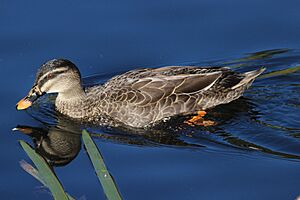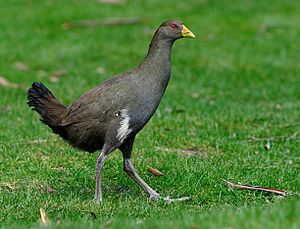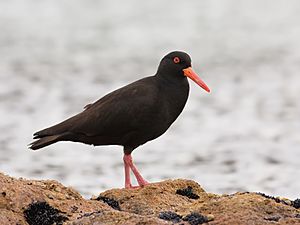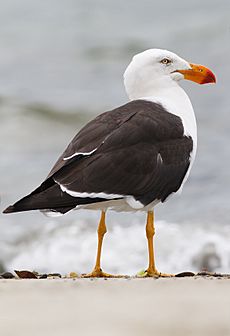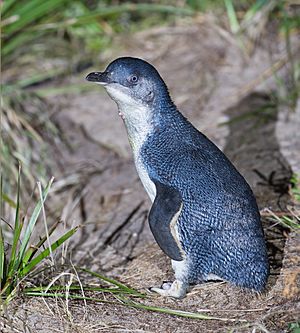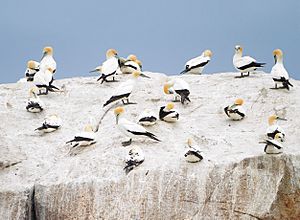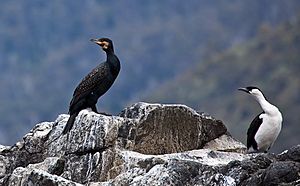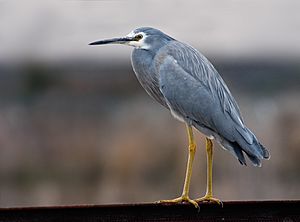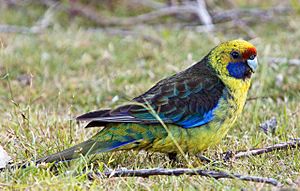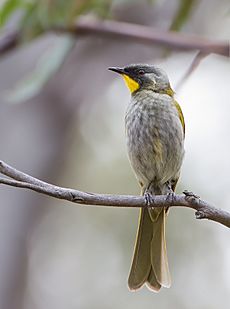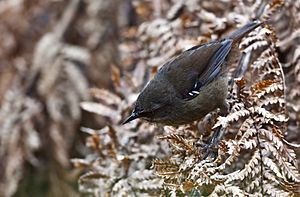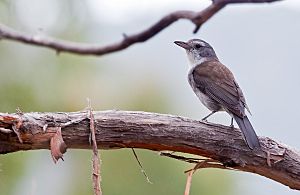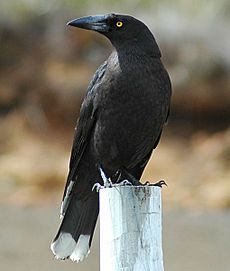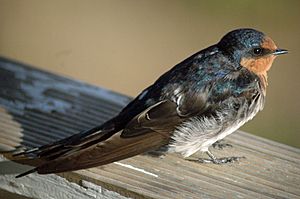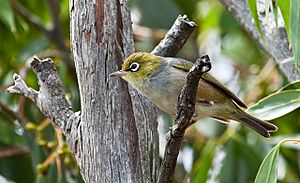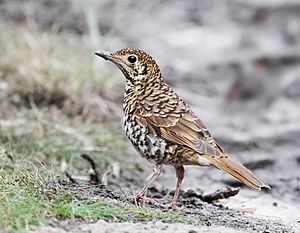List of birds of Tasmania facts for kids
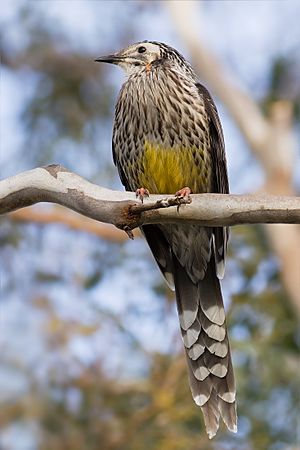
Tasmania, a beautiful island state in Australia, is home to many amazing birds! Over 380 different types of birds have been seen living in the wild here, including on the smaller islands nearby and in the Bass Strait. This list doesn't include birds from Macquarie Island.
Tasmania has 12 bird species that are endemic to the island. This means they are found only in Tasmania and nowhere else in the world! Most of these special birds are common, but some, like the forty-spotted pardalote, are quite rare. Tasmania is also home to the world's only migratory parrots, and both of these species are currently facing threats.
Some types of penguins visit Tasmania's shores in late summer. Because of its unique birds, Tasmania is known as an "Endemic Bird Area" (EBA). These are special places around the world that have at least two bird species found only there.
Even though Tasmania has been separated from mainland Australia for about 10,000 years, the islands in the Bass Strait have helped many birds travel between the two landmasses. Tasmania has about 5,400 kilometers (3,400 miles) of coastline and 350 islands, making it a wonderful home for many different birds.
You'll find lots of birds in Tasmania's wetlands and waterways. Ten of these watery places are so important that they are protected by an international agreement called the Ramsar Convention. Many birds that migrate long distances use Tasmania's bays, mudflats, and beaches to find food. This includes threatened birds like the hooded plover and little tern, which also lay their eggs along the coast. The critically endangered orange-bellied parrot breeds in the button grass grasslands of the southwest. Many rare birds live in Tasmania's eucalyptus forests or rainforests, which cover a large part of the island.
This list uses British English names for birds. Unless noted, all birds listed here live in Tasmania regularly. Some are permanent residents, while others visit in summer or winter, or are just passing through.
Here are some special codes you'll see:
- (I) – Introduced: Birds brought to Tasmania by humans.
- (Ex) – Extinct: Birds that no longer exist.
- (V) – Uncommon vagrants: Birds that are rarely seen in Tasmania.
- (E) – Endemic: Birds found only in Tasmania.
Contents
- Big Birds: Emus and Geese
- Ducks, Geese, and Waterfowl
- Quails and Pheasants
- Grebes: Diving Birds
- Pigeons and Doves
- Cuckoos: Tricky Birds
- Nocturnal Birds: Frogmouths and Owlet-Nightjars
- Swifts: Birds of the Air
- Rails, Gallinules, and Coots: Shy Water Birds
- Shorebirds and Waders
- Seabirds
- Skuas and Jaegers: Strong Fliers
- Gulls, Terns, and Skimmers: Coastal Birds
- Tropicbirds: Long-Tailed Ocean Birds
- Penguins: Flightless Swimmers
- Albatrosses: Giants of the Sky
- Southern Storm-Petrels: Small Seabirds
- Shearwaters and Petrels: True Ocean Wanderers
- Frigatebirds: Aerial Masters
- Boobies and Gannets: Plunge Divers
- Anhingas: Snake-Necked Divers
- Cormorants and Shags: Dark Water Birds
- Pelicans: Pouch-Billed Birds
- Herons, Egrets, and Bitterns: Wading Birds
- Ibises and Spoonbills: Long-Billed Waders
- Birds of Prey
- Colorful Birds
- Falcons: Fast Hunters=
- Parrots and Cockatoos
- Songbirds and Perching Birds
- Lyrebirds: Amazing Mimics
- Australasian Treecreepers: Bark Climbers
- Fairywrens: Tiny Insect Eaters
- Honeyeaters: Nectar Lovers
- Pardalotes: Small and Bright
- Thornbills and Allies: Small Insect Eaters
- Quail-Thrushes: Ground Dwellers
- Cuckooshrikes: Drab but Interesting
- Whistlers and Allies: Talented Singers
- Old World Orioles: Colorful Songbirds
- Woodswallows, Bellmagpies, and Allies: Familiar Australian Birds
- Fantails: Agile Insect Hunters
- Monarch Flycatchers: Forest Dwellers
- Crows, Jays, and Magpies: Smart Birds
- Australasian Robins: Red-Breasted Beauties
- Larks: Ground Birds with Songs
- Cisticolas and Allies: Small Passerines
- Reed Warblers: Wetland Birds
- Grassbirds and Allies: Insect-Eating Songbirds
- Swallows: Aerial Feeders
- White-eyes: Fluffy Birds
- Starlings: Gregarious Birds
- Thrushes and Allies: Old World Songbirds
- Flowerpeckers: Small and Bright
- Waxbills and Allies: Finch-Like Birds
- Old World Sparrows: Common Seed Eaters
- Wagtails and Pipits: Ground Feeders
- Finches and Allies: Seed-Eating Songbirds
- See also
Big Birds: Emus and Geese
Emus: Tasmania's Lost Giants
Order: Casuariformes Family: Dromaiidae
Long ago, two types of emus lived in Tasmania, but they are now gone. The King Island emu disappeared around 1802, and the emus on mainland Tasmania were gone by 1865. It's not clear if the Tasmanian emu was a separate type or not.
- Emu, Dromaius novaehollandiae (extirpated)
- Tasmanian emu, D. h. diemenensis (Ex) (E)
- King Island emu, D. h. minor (Ex) (E)
Magpie Goose: A Rare Visitor
Order: Anseriformes Family: Anseranatidae
The magpie goose is a very old type of bird, different from other ducks and geese. It's only seen in Tasmania sometimes.
- Magpie goose, Anseranus semipalmata (V)
Ducks, Geese, and Waterfowl
Order: Anseriformes Family: Anatidae
This family includes ducks, geese, and swans. These birds are great at living in water! They have webbed feet, flat bills, and special feathers that shed water.
- Cape Barren goose, Cereopsis novaehollandiae
- Black swan, Cygnus atratus
- Australian shelduck, Tadorna tadornoides
- Australian wood duck, Chenonetta jubata
- Pacific black duck, Anas superciliosa
- Mallard, Anas platyrhynchos (I)
- Grey teal, Anas gracilis
- Chestnut teal, Anas castanea
- Musk duck, Biziura lobata
Quails and Pheasants
New World Quail: An Introduced Species
Order: Galliformes Family: Odontophoridae
New World quails are small, plump birds that live on the ground. They look like Old World quails but are not closely related. One type, the California quail, now lives in Tasmania after being brought here by humans.
- California quail, Callipepla californica (I)
Pheasants, Grouse, and Allies
Order: Galliformes Family: Phasianidae
This family includes pheasants and their relatives. They are ground-dwelling birds, often plump with short, broad wings. Many are hunted for sport or raised for food. Two species are native to Tasmania.
- Brown quail, Coturnix ypsilophora
- Stubble quail, Coturnix pectoralis
- Ring-necked pheasant, Phasianus colchicus (I)
Grebes: Diving Birds
Order: Podicipediformes Family: Podicipedidae
Grebes are small to medium-sized birds that dive in freshwater. They have special lobed toes that help them swim and dive very well. However, their feet are set far back on their bodies, making them clumsy on land. Three species have been seen in Tasmania.
- Australasian grebe, Tachybaptus novaehollandiae
- Hoary-headed grebe, Poliocephalus poliocephalus
- Great crested grebe, Podiceps cristatus
Pigeons and Doves
Order: Columbiformes Family: Columbidae
Pigeons and doves are birds with sturdy bodies, short necks, and thin bills. Eight species have been recorded in Tasmania.
- Rock pigeon, Columba livia (I)
- Common bronzewing, Phaps chalcoptera
- Brush bronzewing, Phaps elegans
Cuckoos: Tricky Birds
Order: Cuculiformes Family: Cuculidae
This family includes cuckoos. These birds vary in size and have slender bodies, long tails, and strong legs.
- Horsfield's bronze-cuckoo, Chrysococcyx basalis
- Shining bronze-cuckoo, Chrysococcyx lucidus
- Pallid cuckoo, Cacomantis pallidus
- Fan-tailed cuckoo, Cacomantis flabelliformis
Nocturnal Birds: Frogmouths and Owlet-Nightjars
Frogmouths: Masters of Disguise
Order: Caprimulgiformes Family: Podargidae
Frogmouths are unique, small birds that are active at night. They are found from India to Australia. One species lives in Tasmania.
- Tawny frogmouth, Podargus strigoides
Owlet-Nightjars: Small Night Birds
Order: Caprimulgiformes Family: Aegothelidae
Owlet-nightjars are another group of small, nocturnal birds. They are found in places like New Guinea and Australia.
- Australian owlet-nightjar, Aegotheles cristatus
Swifts: Birds of the Air
Order: Caprimulgiformes Family: Apodidae
Swifts are small birds that spend most of their lives flying! They have very short legs and almost never land on the ground. Instead, they perch on vertical surfaces. Many swifts have long, swept-back wings that look like a crescent moon.
- White-throated needletail, Hirundapus caudacutus
- Pacific swift, Apus pacificus
Rails, Gallinules, and Coots: Shy Water Birds
Order: Gruiformes Family: Rallidae
This is a large family of small to medium-sized birds like rails, crakes, coots, and gallinules. They usually live in thick plants near lakes, swamps, or rivers. They are often shy and hard to spot. Most have strong legs and long toes, perfect for soft, uneven ground. They tend to have short, rounded wings and are not strong flyers.
- Lewin's rail, Lewinia pectoralis
- Tasmanian nativehen, Tribonyx mortierii (E)
- Australian crake, Porzana fluminea
- Dusky moorhen, Gallinula tenebrosa
- Eurasian coot, Fulica atra
- Australasian swamphen, Porphyrio melanotus
Shorebirds and Waders
Thick-knees: Large-Eyed Night Birds
Order: Charadriiformes Family: Burhinidae
Thick-knees are mostly tropical birds that are active at night. They have strong black or yellow-black bills, large yellow eyes, and camouflage feathers. One species is a rare visitor to Tasmania.
- Bush thick-knee, Burhinus grallarius (V)
Stilts and Avocets: Long-Legged Waders
Order: Charadriiformes Family: Recurvirostridae
This family includes avocets and stilts, which are large wading birds. Avocets have long legs and bills that curve upwards. Stilts have extremely long legs and long, thin, straight bills. All three species found on the mainland have been seen in Tasmania.
- Pied stilt, Himantopus leucocephalus (V)
- Red-necked avocet, Recurvirostra novaehollandiae (V)
Oystercatchers: Shellfish Eaters
Order: Charadriiformes Family: Haematopodidae
Oystercatchers are large, noisy birds that look like plovers. They have strong bills that they use to smash or pry open shellfish. Two species have been seen in Tasmania.
- Pied oystercatcher, Haematopus longirostris
- Sooty oystercatcher, Haematopus fuliginosus
Lapwings and Plovers: Open Country Birds
Order: Charadriiformes Family: Charadriidae
This family includes plovers, dotterels, and lapwings. They are small to medium-sized birds with compact bodies and short, thick necks. They often live in open areas, especially near water. In Tasmania, ten species have been recorded.
- Black-bellied plover, Pluvialis squatarola
- Pacific golden-plover, Pluvialis fulva
- Banded lapwing, Vanellus tricolor
- Masked lapwing, Vanellus miles
- Red-capped plover, Charadrius ruficapillus
- Hooded plover, Thinornis cucullatus
- Black-fronted dotterel, Elseyornis melanops
Painted-Snipe: A Rare Australian Visitor
Order: Charadriiformes Family: Rostratulidae
Painted-snipes are a family of three snipe-like birds found in South America, Asia, and Australia. The Australian species is a rare visitor to Tasmania.
- Australian painted-snipe, Rostratula australis (V)
Sandpipers and Allies: Diverse Shorebirds
Order: Charadriiformes Family: Scolopacidae

This is a large and varied family of small to medium-sized shorebirds. It includes sandpipers, curlews, godwits, and snipes. Most of these birds eat small invertebrates (like worms) from mud or soil. Different bill and leg lengths allow many species to feed in the same areas without competing for food.
- Whimbrel, Numenius phaeopus
- Far Eastern curlew, Numenius madagascariensis
- Bar-tailed godwit, Limosa lapponica
- Ruddy turnstone, Arenaria interpres
- Great knot, Calidris tenuirostris
- Red knot, Calidris canutus
- Sharp-tailed sandpiper, Calidris acuminata
- Curlew sandpiper, Calidris ferruginea

- Red-necked stint, Calidris ruficollis
- Sanderling, Calidris alba
- Latham's snipe, Gallinago hardwickii
- Common sandpiper, Actitis hypoleucos
- Grey-tailed tattler, Tringa brevipes
- Common greenshank, Tringa nebularia
Buttonquail: Quail-Like Shorebirds
Order: Charadriiformes Family: Turnicidae
Buttonquail are an ancient group of shorebirds that look a lot like true quails, but they are not related. They are found in Africa, Asia, and Australia, with one species reaching Tasmania.
- Painted buttonquail, Turnix varius
Seabirds
Skuas and Jaegers: Strong Fliers
Order: Charadriiformes Family: Stercorariidae
Skuas are medium to large birds, usually grey or brown, often with white marks on their wings. They have longish bills with hooked tips and webbed feet with sharp claws. They are strong, acrobatic flyers.
- Brown skua, Stercorarius antarcticus
- Pomarine jaeger, Stercorarius pomarinus
- Parasitic jaeger, Stercorarius parasiticus
Gulls, Terns, and Skimmers: Coastal Birds
Order: Charadriiformes Family: Laridae
Gulls are typically medium to large birds, usually grey or white, often with black markings. They have strong, longish bills and webbed feet. Terns are generally medium to large birds, usually grey or white, often with black markings on their heads. They are lighter and more streamlined than gulls and look graceful in flight with long tails and narrow wings. In Tasmania, three species of gulls and thirteen species of terns have been recorded.
- Silver gull, Chroicocephalus novaehollandiae
- Pacific gull, Larus pacificus
- Kelp gull, Larus dominicanus
- Little tern, Sternula albifrons
- Australian fairy tern, Sternula nereis
- Caspian tern, Hydroprogne caspia
- White-winged tern, Chlidonias leucopterus
- White-fronted tern, Sterna striata
- Great crested tern, Thalasseus bergii
Tropicbirds: Long-Tailed Ocean Birds
Order: Phaethontiformes Family: Phaethontidae
Tropicbirds are slender white birds of tropical oceans, known for their exceptionally long central tail feathers. Their long wings have black markings, as does their head. One species is a rare visitor to Tasmanian waters.
- Red-tailed tropicbird, Phaethon rubricauda (V)
Penguins: Flightless Swimmers
Order: Sphenisciformes Family: Spheniscidae
Penguins are a group of water birds that cannot fly. They live almost entirely in the Southern Hemisphere, especially in Antarctica. One species, the Little Penguin, breeds on the Tasmanian coast.
- Little penguin, Eudyptula minor
- King penguin, Aptenodytes patagonicus (V)
- Adelie penguin, Pygoscelis adeliae (V)
- Gentoo penguin, Pygoscelus papua (V)
Albatrosses: Giants of the Sky
Order: Procellariiformes Family: Diomedeidae
Albatrosses are a family of large seabirds found in the Southern and North Pacific Oceans. The largest ones are among the biggest flying birds in the world!
- Yellow-nosed albatross, Thalassarche chlororhynchos
- Grey-headed albatross, Thalassarche chrysostoma
- White-capped albatross, Thalassarche cauta
- Black-browed albatross, Thalassarche melanophris
- Sooty albatross, Phoebetria fusca
- Light-mantled albatross, Phoebetria palpebrata
- Wandering albatross, Diomedea exulans
Southern Storm-Petrels: Small Seabirds
Order: Procellariiformes Family: Oceanitidae
Southern storm-petrels are the smallest seabirds. They are related to petrels and feed on tiny sea creatures and small fish from the water's surface, often while hovering. Their flight is fluttery, sometimes like a bat.
- Wilson's storm-petrel, Oceanites oceanicus
- Grey-backed storm-petrel, Garrodia nereis
- White-faced storm-petrel, Pelagodroma marina
- Black-bellied storm-petrel, Fregetta tropica
Shearwaters and Petrels: True Ocean Wanderers
Order: Procellariiformes Family: Procellariidae
This is the main group of medium-sized "true petrels." They have nostrils that are joined together and a long outer flight feather.

- Southern giant-petrel, Macronectes giganteus
- Northern giant-petrel, Macronectes halli
- Cape petrel, Daption capense
- Great-winged petrel, Pterodroma macroptera
- Providence petrel, Pterodroma solandri
- White-headed petrel, Pterodroma lessonii
- Blue petrel, Halobaena caerulea
- Fairy prion, Pachyptila turtur
- Antarctic prion, Pachyptila desolata
- White-chinned petrel, Procellaria aequinoctialis
- Sooty shearwater, Ardenna griseus
- Short-tailed shearwater, Ardenna tenuirostris
- Hutton's shearwater, Puffinus huttoni
- Fluttering shearwater, Puffinus gavia
- Little shearwater, Puffinus assimilis
- Common diving-petrel, Pelecanoides urinatrix
Frigatebirds: Aerial Masters
Order: Suliformes Family: Fregatidae
Frigatebirds are large seabirds usually found over tropical oceans. They are big, black, or black-and-white, with long wings and deeply forked tails. Males have colorful throat pouches that they can inflate. They don't swim or walk well and can't take off from a flat surface. They have the largest wingspan compared to their body weight of any bird, allowing them to stay in the air for more than a week!
- Lesser frigatebird, Fregata ariel (V)
- Great frigatebird, Fregata minor (V)
Boobies and Gannets: Plunge Divers
Order: Suliformes Family: Sulidae
This family includes gannets and boobies. Both are medium-large coastal seabirds that dive headfirst into the water to catch fish.
- Australasian gannet, Morus serrator
Anhingas: Snake-Necked Divers
Order: Suliformes Family: Anhingidae
Darters are water birds that look like cormorants, with long necks and straight bills. They eat fish and often swim with only their neck above the water, looking like a snake! One species is a rare visitor to Tasmania.
- Australasian darter, Anhinga novaehollandiae (V)
Cormorants and Shags: Dark Water Birds
Order: Suliformes Family: Phalacrocoracidae
Cormorants are medium to large water birds, usually with dark feathers and colored skin on their faces. Their bill is long, thin, and sharply hooked. They have four webbed toes, which is a special feature among their bird group.
- Little pied cormorant, Microcarbo melanoleucos
- Great cormorant, Phalacrocorax carbo
- Little black cormorant, Phalacrocorax sulcirostris
- Black-faced cormorant, Phalacrocorax fuscescens
Pelicans: Pouch-Billed Birds
Order: Pelecaniformes Family: Pelecanidae
Pelicans are large water birds with a unique pouch under their bills. Like other birds in their group, they have four webbed toes. One species has been seen in Tasmania.
- Australian pelican, Pelecanus conspicillatus
Herons, Egrets, and Bitterns: Wading Birds
Order: Pelecaniformes Family: Ardeidae
This family includes herons, egrets, and bitterns. Herons and egrets are medium to large wading birds with long necks and legs. Bitterns tend to have shorter necks and are more secretive. These birds fly with their necks pulled back, unlike other long-necked birds.
- Australasian bittern, Botaurus poiciloptilus
- Pacific heron, Ardea pacifica
- Great egret, Ardea alba
- White-faced heron, Egretta novaehollandiae
- Little egret, Egretta garzetta
- Cattle egret, Bubulcus ibis
- Nankeen night-heron, Nycticorax caledonicus
Ibises and Spoonbills: Long-Billed Waders
Order: Pelecaniformes Family: Threskiornithidae
This family includes ibises and spoonbills. They have long, broad wings and long bodies with long legs. Their bills are also long: ibises have downward-curved bills, while spoonbills have straight, flat, spoon-shaped bills.
- Royal spoonbill, Platalea regia
Birds of Prey
Osprey: The Fish Hunter
Order: Accipitriformes Family: Pandionidae
The family Pandionidae has only one species: the osprey. The osprey is a medium-large bird of prey that specializes in eating fish. It is found all over the world.
- Osprey, Pandion haliaetus (V)
Hawks, Eagles, and Kites: Powerful Hunters
Order: Accipitriformes Family: Accipitridae
This family includes hawks, eagles, kites, and harriers. These birds of prey have large, strong, hooked beaks for tearing meat from their prey. They also have strong legs, powerful talons (claws), and excellent eyesight.
- Wedge-tailed eagle, Aquila audax
- Tasmanian wedge-tailed eagle, A. a. fleayi (E)
- Swamp harrier, Circus approximans
- Grey goshawk, Accipiter novaehollandiae
- Brown goshawk, Accipiter fasciatus
- Collared sparrowhawk, Accipiter cirrocephalus
- White-bellied sea-eagle, Haliaeetus leucogaster
Barn Owls: Heart-Faced Hunters
Order: Strigiformes Family: Tytonidae
Barn owls are medium to large owls with big heads and unique heart-shaped faces. They have long, strong legs with powerful talons.
- Australian masked owl, Tyto novaehollandiae
Owls: Night Hunters
Order: Strigiformes Family: Strigidae
Typical owls are solitary birds of prey that hunt at night. They have large, forward-facing eyes and ears, a hawk-like beak, and a clear circle of feathers around each eye called a facial disk.
- Tasmanian boobook, Ninox leucopsis (E)
Colorful Birds
Kingfishers: Brightly Colored Divers
Order: Coraciiformes Family: Alcedinidae
Kingfishers are medium-sized birds with large heads, long pointed bills, short legs, and stubby tails.
- Azure kingfisher, Ceyx azurea
- Laughing kookaburra, Dacelo novaeguineae (I)
- Sacred kingfisher, Todiramphus sanctus
Bee-eaters: Insect Eaters
Order: Coraciiformes Family: Meropidae
Bee-eaters are known for their richly colored feathers, slender bodies, and usually long central tail feathers. They all have long, downturned bills and pointed wings, which make them look like swallows when flying.
- Rainbow bee-eater, Merops ornatus (V)
Rollers: Crow-Sized Beauties
Order: Coraciiformes Family: Coraciidae
Rollers are similar in size and shape to crows, but they are more closely related to kingfishers and bee-eaters. They are also very colorful, mostly blue and brown.
- Dollarbird, Eurystomus orientalis (V)
Falcons: Fast Hunters=
Order: Falconiformes Family: Falconidae
This family includes falcons. They are different from hawks and eagles because they kill their prey with their beaks instead of their talons.
- Nankeen kestrel, Falco cenchroides
- Australian hobby, Falco longipennis
- Brown falcon, Falco berigora
- Peregrine falcon, Falco peregrinus
Parrots and Cockatoos
Cockatoos: Crested and Noisy
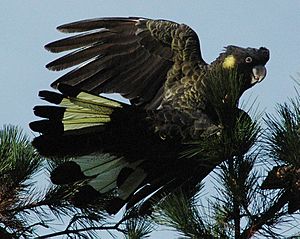
Order: Psittaciformes Family: Cacatuidae
Cockatoos are a special group of parrots known for their crests (feathers on their heads) and usually plain-colored feathers. They are generally large and noisy, and a common sight in Australia and Tasmania.
- Yellow-tailed black cockatoo, Calyptorhynchus funereus
- Southern yellow-tailed black cockatoo, C. f. xanthanota
- Galah, Eolophus roseicapilla (I)
- Sulphur-crested cockatoo, Cacatua galerita
Old World Parrots: Colorful and Clever
Order: Psittaciformes Family: Psittaculidae
Parrots have strong, curved bills, stand upright, and have strong legs with clawed feet that can grip branches. Many parrots are brightly colored. Old World parrots are found from Africa to Australia and New Zealand.
- Ground parrot, Pezoporus wallicus
- Blue-winged parrot, Neophema chrysostoma
- Orange-bellied parrot, Neophema chrysogaster
- Swift parrot, Lathamus discolor
- Green rosella, Platycercus caledonicus (E)
- Eastern rosella, Platycercus eximius
- Musk lorikeet, Glossopsitta concinna
Songbirds and Perching Birds
Lyrebirds: Amazing Mimics
Order: Passeriformes Family: Menuridae
Lyrebirds are two species of Australian birds that live on the ground. They are famous for being incredible mimics, meaning they can copy many different sounds. One species has been brought to Tasmania.
- Superb lyrebird, Menura novaehollandiae (I)
Australasian Treecreepers: Bark Climbers
Order: Passeriformes Family: Climacteridae
These are medium-small, mostly brown birds with patterns on their undersides.
- White-throated treecreeper, Cormobates leucophaea (V)
Fairywrens: Tiny Insect Eaters
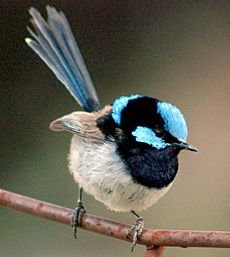
Order: Passeriformes Family: Maluridae
Fairywrens are a family of small birds that eat insects. They are found only in Australia and New Guinea. Two species are native to Tasmania.
- Southern emuwren, Stipiturus malachurus
- Superb fairywren, Malurus cyaneus
Honeyeaters: Nectar Lovers
Order: Passeriformes Family: Meliphagidae
Honeyeaters are a varied group of birds that eat nectar and insects. They are found across Australia and nearby areas. Eleven species live in Tasmania, and four of these are endemic, including Australia's largest honeyeater, the yellow wattlebird.
- Eastern spinebill, Acanthorhynchus tenuirostris
- Noisy miner, Manorina melanocephala
- Little wattlebird, Anthochaera chrysoptera
- Yellow wattlebird, Anthochaera paradoxa (E)
- White-fronted chat, Epthianura albifrons
- Tawny-crowned honeyeater, Gliciphila melanops
- Crescent honeyeater, Phylidonyris pyrrhoptera
- New Holland honeyeater, Phylidonyris novaehollandiae
- Yellow-throated honeyeater, Nesoptilotis flavicollis (E)
- Black-headed honeyeater, Melithreptus affinis (E)
- Strong-billed honeyeater, Melithreptus validirostris (E)
Pardalotes: Small and Bright
Order: Passeriformes Family: Pardalotidae
Pardalotes are a small family of very tiny, brightly colored birds native to Australia. They have short tails, strong legs, and blunt beaks. They eat insects, usually from the tops of eucalyptus trees, and nest in burrows. Three species are found in Tasmania, and one of them is endemic and endangered.
- Spotted pardalote, Pardalotus punctatus
- Forty-spotted pardalote, Pardalotus quadragintus (E)
- Striated pardalote, Pardalotus striatus
Thornbills and Allies: Small Insect Eaters
Order: Passeriformes Family: Acanthizidae
This group includes 35 species of small to medium-sized birds that mostly eat insects. They have short, rounded wings, thin bills, long legs, and short tails. Most have olive, grey, or brown feathers. Six species are found in Tasmania, and three of them are endemic.
- White-browed scrubwren, Sericornis frontalis
- Tasmanian scrubwren, Sericornis humilis (E)
- Scrubtit, Acanthornis magnus (E)
- Striated fieldwren, Calamanthus fuliginosus
- Brown thornbill, Acanthiza pusilla
- Tasmanian thornbill, Acanthiza ewingii (E)
- Yellow-rumped thornbill, Acanthiza chrysorrhoa
Quail-Thrushes: Ground Dwellers
Order: Passeriformes Family: Cinclosomatidae
Quail-thrushes are medium-sized songbirds found in open forests. They are adapted to living on the ground and have strong legs and beaks. One species reaches Tasmania.
- Spotted quail-thrush, Cinclosoma punctatum
Cuckooshrikes: Drab but Interesting
Order: Passeriformes Family: Campephagidae
Cuckooshrikes are a family of mostly dull-colored birds that eat insects. They are not related to cuckoos or shrikes.
- Black-faced cuckooshrike, Coracina novaehollandiae
Whistlers and Allies: Talented Singers
Order: Passeriformes Family: Pachycephalidae
This large group of birds includes whistlers and shrikethrushes. They are mostly insect eaters, but larger species might also eat small animals like frogs. Most have dull feathers, but some are very good singers.
- Grey shrikethrush, Colluricincla harmonica
- Olive whistler, Pachycephala olivacea
- Golden whistler, Pachycephala pectoralis
Old World Orioles: Colorful Songbirds
Order: Passeriformes Family: Oriolidae
Old World orioles are colorful songbirds. They are not related to the New World orioles.
- Olive-backed oriole, Oriolus sagittatus (V)
Woodswallows, Bellmagpies, and Allies: Familiar Australian Birds
Order: Passeriformes Family: Artamidae
This family includes crow-like birds and the smaller woodswallows. They are some of the most well-known and best singing birds in Australia and Tasmania. Six species are found in Tasmania.
- Dusky woodswallow, Artamus cyanopterus
- Grey butcherbird, Cracticus torquatus
- Australian magpie, Gymnorhina tibicen
- Black currawong, Strepera fuliginosa (E)
- Grey currawong, Strepera versicolor
Fantails: Agile Insect Hunters
Order: Passeriformes Family: Rhipiduridae
Fantails are a family of small birds that eat insects. They are known for their fanned tails.
- Grey fantail, Rhipidura fuliginosa
Monarch Flycatchers: Forest Dwellers
Order: Passeriformes Family: Monarchidae
Monarch flycatchers are a diverse family of about 140 species of birds found from Africa to Australia. They generally live in the upper or lower parts of forests.
- Satin flycatcher, Myiagra cyanoleuca
Crows, Jays, and Magpies: Smart Birds
Order: Passeriformes Family: Corvidae
This family includes crows, ravens, and magpies. These birds are larger than average for their group, and some of the bigger species are very intelligent. Two black-feathered ravens are found in Tasmania.
- Little raven, Corvus mellori
- Forest raven, Corvus tasmanicus
Australasian Robins: Red-Breasted Beauties
Order: Passeriformes Family: Petroicidae
Australasian robins are a group of small birds that eat insects. The males of many species have bright red or pink feathers on their chests.
- Scarlet robin, Petroica boodang
- Flame robin, Petroica phoenicea
- Pink robin, Petroica rodinogaster
- Dusky robin, Melanodryas vittata (E)
Larks: Ground Birds with Songs
Order: Passeriformes Family: Alaudidae
Larks are small birds that live on the ground. They are known for their often elaborate songs and display flights. Most larks are fairly plain in color. They eat insects and seeds.
- Eurasian skylark, Alauda arvensis (I)
Cisticolas and Allies: Small Passerines
Order: Passeriformes Family: Cisticolidae
Cisticolas and their allies are a family of about 110 small birds found mainly in warmer southern parts of the Old World. One species reaches Tasmania.
- Golden-headed cisticola, Cisticola exilis
Reed Warblers: Wetland Birds
Order: Passeriformes Family: Acrocephalidae
Members of this family are usually quite large for "warblers." Most are plain olive-brown on top and yellowish or beige underneath. They are usually found in open woodlands, reedbeds, or tall grass.
- Australian reed warbler, Acrocephalus australis
Grassbirds and Allies: Insect-Eating Songbirds
Order: Passeriformes Family: Locustellidae
Grassbirds and songlarks are a newly recognized family of small birds that eat insects.
- Little grassbird, Poodytes gramineus
Swallows: Aerial Feeders
Order: Passeriformes Family: Hirundinidae
The swallow family is adapted to catching food while flying. They have slender, streamlined bodies, long pointed wings, and short bills with wide mouths. Their feet are made for perching, not walking.
- Welcome swallow, Hirundo neoxena
- Tree martin, Petrochelidon nigricans
White-eyes: Fluffy Birds
Order: Passeriformes Family: Zosteropidae
White-eyes are a large family of mostly Old World birds. They vary in size and color but are known for their soft, fluffy feathers. These are tropical birds, and one species reaches Tasmania.
- Silvereye, Zosterops lateralis
Starlings: Gregarious Birds
Order: Passeriformes Family: Sturnidae
Starlings are small to medium-sized Old World birds with strong feet. They fly strongly and directly, and most live in groups. They prefer open country and eat insects and fruit. The feathers of some species are dark with a metallic shine.
- European starling, Sturnus vulgaris (I)
- Common myna, Acridotheres tristis (I)
Thrushes and Allies: Old World Songbirds
Order: Passeriformes Family: Turdidae
True thrushes are a group of songbirds found mainly in the Old World.
- Bassian thrush, Zoothera lunulata
- Song thrush, Turdus philomelos (I)
- Eurasian blackbird, Turdus merula (I)
Flowerpeckers: Small and Bright
Order: Passeriformes Family: Dicaeidae
Flowerpeckers are very small, sturdy, often brightly colored birds with short tails, short, thick, curved bills, and tubular tongues.
- Mistletoebird, Dicaeum hirundinaceum (V)
Waxbills and Allies: Finch-Like Birds
Order: Passeriformes Family: Estrildidae
Estrildid finches are small birds that look like finches or sparrows. They are found in the Old World tropics and Australasia. One species reaches Tasmania.
- Beautiful firetail, Stagonopleura bella
Old World Sparrows: Common Seed Eaters
Order: Passeriformes Family: Passeridae
Old World sparrows are small birds. They tend to be plump, brownish or grayish, with short tails and strong, short beaks. Sparrows eat seeds, but they also eat small insects. One species has been brought to Tasmania.
- House sparrow, Passer domesticus (I)
Wagtails and Pipits: Ground Feeders
Order: Passeriformes Family: Motacillidae
This family includes wagtails and pipits. They are slender, insect-eating birds that feed on the ground in open areas.
- Australian pipit, Anthus australis
Finches and Allies: Seed-Eating Songbirds
Order: Passeriformes Family: Fringillidae
Finches are seed-eating birds that are small to medium-sized. They have strong, often cone-shaped beaks. All have twelve tail feathers and nine primary flight feathers. These birds have a bouncy flight, and most sing well.
- European greenfinch, Chloris chloris (I)
- European goldfinch, Carduelis carduelis (I)
|
See also
- List of Australian birds
- List of Australian, New Zealand and Antarctic birds
- Birds of Australia
- Lists of birds by region


